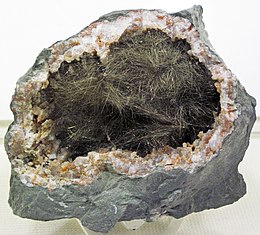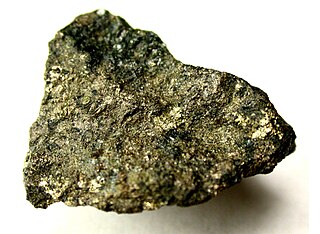
Pentlandite is an iron–nickel sulfide with the chemical formula (Fe,Ni)9S8. Pentlandite has a narrow variation range in nickel to iron ratios (Ni:Fe), but it is usually described as 1:1. In some cases, this ratio is skewed by the presence of pyrrhotite inclusions. It also contains minor cobalt, usually at low levels as a fraction of weight.

Serpentine subgroup are greenish, brownish, or spotted minerals commonly found in serpentinite. They are used as a source of magnesium and asbestos, and as decorative stone. The name comes from the greenish color and smooth or scaly appearance from the Latin serpentinus, meaning "snake-like".
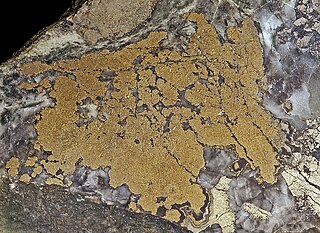
Nickeline or niccolite is a mineral consisting primarily of nickel arsenide (NiAs). The naturally-occurring mineral contains roughly 43.9% nickel and 56.1% arsenic by mass, but composition of the mineral may vary slightly.

Pyrrhotite is an iron sulfide mineral with the formula Fe(1-x)S. It is a nonstoichiometric variant of FeS, the mineral known as troilite. Pyrrhotite is also called magnetic pyrite, because the color is similar to pyrite and it is weakly magnetic. The magnetism decreases as the iron content increases, and troilite is non-magnetic. Pyrrhotite is generally tabular and brassy/bronze in color with a metallic luster. The mineral occurs with mafic igneous rocks like norites, and may form from pyrite during metamorphic processes. Pyrrhotite is associated and mined with other sulfide minerals like pentlandite, pyrite, chalcopyrite, and magnetite, and has been found globally.

Anthophyllite is an orthorhombic amphibole mineral: ☐Mg2Mg5Si8O22(OH)2 (☐ is for a vacancy, a point defect in the crystal structure), magnesium iron inosilicate hydroxide. Anthophyllite is polymorphic with cummingtonite. Some forms of anthophyllite are lamellar or fibrous and are classed as asbestos. The name is derived from the Latin word anthophyllum, meaning clove, an allusion to the most common color of the mineral. The Anthophyllite crystal is characterized by its perfect cleavage along directions 126 degrees and 54 degrees.

Komatiite is a type of ultramafic mantle-derived volcanic rock defined as having crystallised from a lava of at least 18 wt% magnesium oxide (MgO). It is classified as a 'picritic rock'. Komatiites have low silicon, potassium and aluminium, and high to extremely high magnesium content. Komatiite was named for its type locality along the Komati River in South Africa, and frequently displays spinifex texture composed of large dendritic plates of olivine and pyroxene.

Sperrylite is a platinum arsenide mineral with the chemical formula PtAs2 and is an opaque metallic tin white mineral which crystallizes in the isometric system with the pyrite group structure. It forms cubic, octahedral or pyritohedral crystals in addition to massive and reniform habits. It has a Mohs hardness of 6–7 and a very high specific gravity of 10.6.
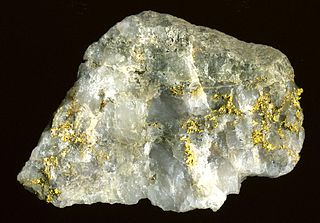
Various theories of ore genesis explain how the various types of mineral deposits form within Earth's crust. Ore-genesis theories vary depending on the mineral or commodity examined.

Hellyerite, NiCO3·6(H2O), is an hydrated nickel carbonate mineral. It is light blue to bright green in colour, has a hardness of 2.5, a vitreous luster, a white streak and crystallises in the monoclinic system. The crystal habit is as platy and mammillary encrustations on its matrix. It is a pentahydrate according to X-ray crystallography. The solid consists of [Ni2(CO3)2(H2O)8] subunits with an extra pair of water of hydration.

Cumulate rocks are igneous rocks formed by the accumulation of crystals from a magma either by settling or floating. Cumulate rocks are named according to their texture; cumulate texture is diagnostic of the conditions of formation of this group of igneous rocks. Cumulates can be deposited on top of other older cumulates of different composition and colour, typically giving the cumulate rock a layered or banded appearance.
Kambalda type komatiitic nickel ore deposits are a class of magmatic iron-nickel-copper-platinum-group element ore deposit in which the physical processes of komatiite volcanology serve to deposit, concentrate and enrich a Fe-Ni-Cu-(PGE) sulfide melt within the lava flow environment of an erupting komatiite volcano.
The Emily Ann and Maggie Hays nickel deposits are situated 117 km west of the town of Norseman, Western Australia, within the Lake Johnston Greenstone Belt.

A native metal is any metal that is found pure in its metallic form in nature. Metals that can be found as native deposits singly or in alloys include antimony, arsenic, bismuth, cadmium, chromium, cobalt, indium, iron, manganese, molybdenum, nickel, niobium, rhenium, tantalum, tellurium, tin, titanium, tungsten, vanadium, and zinc, as well as the gold group and the platinum group. Among the alloys found in native state have been brass, bronze, pewter, German silver, osmiridium, electrum, white gold, silver-mercury amalgam, and gold-mercury amalgam.

Gaspéite, a very rare nickel carbonate mineral, with the formula (Ni,Fe,Mg)CO3, is named for the place it was first described, in the Gaspé Peninsula, Québec, Canada.

Heazlewoodite, Ni3S2, is a rare sulfur-poor nickel sulfide mineral found in serpentinitized dunite. It occurs as disseminations and masses of opaque, metallic light bronze to brassy yellow grains which crystallize in the trigonal crystal system. It has a hardness of 4, a specific gravity of 5.82. Heazlewoodite was first described in 1896 from Heazlewood, Tasmania, Australia.
Violarite (Fe2+Ni23+S4) is a supergene sulfide mineral associated with the weathering and oxidation of primary pentlandite nickel sulfide ore minerals.

Oregonite, Ni2FeAs2 is a nickel iron arsenide mineral first described from Josephine Creek, Oregon, United States.
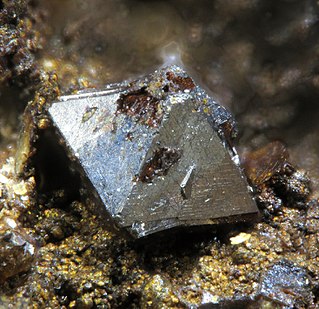
Polydymite, Ni2+Ni23+S4, is a supergene thiospinel sulfide mineral associated with the weathering of primary pentlandite nickel sulfide.
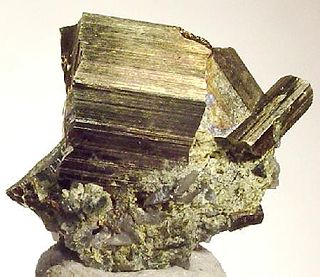
Cubanite is a copper iron sulfide mineral that commonly occurs as a minor alteration mineral in magmatic sulfide deposits. It has the chemical formula CuFe2S3 and when found, it has a bronze to brass-yellow appearance. On the Mohs hardness scale, cubanite falls between 3.5 and 4 and has a orthorhombic crystal system. Cubanite is chemically similar to chalcopyrite; however, it is the less common copper iron sulfide mineral due to crystallization requirements.
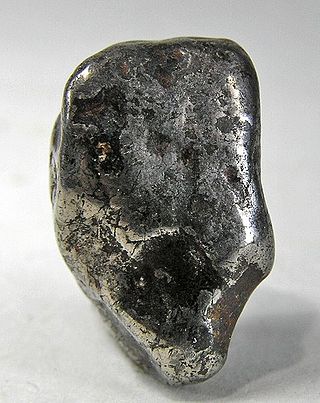
Awaruite is a naturally occurring alloy of nickel and iron with a composition from Ni2Fe to Ni3Fe.
